Meet one of the most innovative wave-generating technologies on the planet.
Surf Lakes is a completely different approach to artificially creating rideable freshwater waves.
And it all started from a very simple concept – the gravity waves’ ripple effect.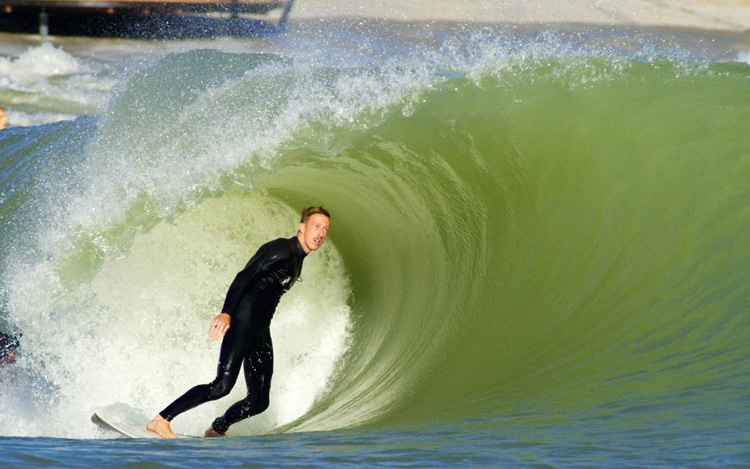
The idea to develop a wave pool around a 1,400-ton mechanical engineering system resembling a plunger or a metal donut started growing around 2006.
The concept evolved inspired by the effect we observe when we throw a rock into the water and witness the ripples disperse.
And that’s precisely how it started. Aaron Trevis was stone skipping in a Brisbane lake when he had a eureka moment.
Unlike other wave pool formulas that push water horizontally, Surf Lakes creates magical concentric swell lines by applying vertical pressure over the surface of a water basin.
Trevis once stated that his team of engineers was able to bring the idea to life “thanks to their mining background and experience with similar amounts of pressure.”
To make the whole scenario even more spectacular, the pressure built by the system escapes the pipe from four vents in the form of white smoke.
Aaron Trevis’ vision was to build a premiere surf venue where surfers could enjoy left and hand-breaking waves, day and night.
It’s where the surf pool company built in 2018 their original full-scale research and development site and where they test and fine-tune the waves.
With its 80 megaliters of water volume, the place is the largest surf lagoon in the world.
Mark Occhilupo, the 1999 world surfing champion, was Surf Lakes’ first ambassador, test surfer, and minority shareholder.
Surf Lakes is located in Murala, near Yeppoon, on Queensland’s Capricorn Coast, Australia.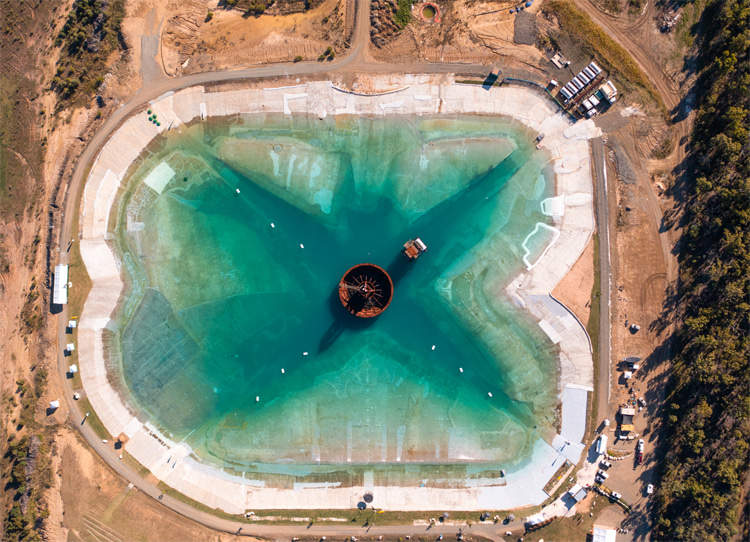
There is also another competitive advantage and differentiating factor that makes Surf Lakes one of the most sought-after wave pool technologies.
It’s its 360-degree wave dispersion.
Every time the central wave device (CWD) goes down, a circular ripple travels across the water lake, allowing surfers to catch more waves in multiple peaks.
Multiple bottom contours and underwater bumps shape different level waves to make things more interesting.
“Our design is different from other wave parks. We can have multiple surfers riding different types of breaks at any time to have barrels for the pros or rolling waves for beginners,” explained Chris Hawley, the engineer at Surf Lakes.
In other words, the giant iron oxide-like machine pushes the water out concentrically from the center of the pool in all directions before the contours shape each wave.
The further the concrete bank and other reef bathymetry are from the center, the smaller the break.
The patent-pending wave generation technique oscillating to create increasing swell surges (up to four meters) also works like a tsunami.
The hydraulic cylinder is the central part of the mechanism. The piston will go down into this.
It is where the pressure surrounds the piston and drives the whole mechanism out of the water.
Surf Lakes displays one of the biggest hydraulic cylinders in the world.
Compressing air through a U-shaped tube, releasing, and dropping the weight into the poll takes around six seconds.
It is then repeated several times to create a wave set. After each set, the compressed air recharges for the next set.
The recovery time between wave sets is about the time surfers need to paddle back to the lineup again.
The lake is split into four parts, separated by special return channels, making it easy and safe for surfers to paddle back out.
They also help calm the water.
Each of the four parts of the lake is designed to make different types of waves so surfers of all skill levels can have fun.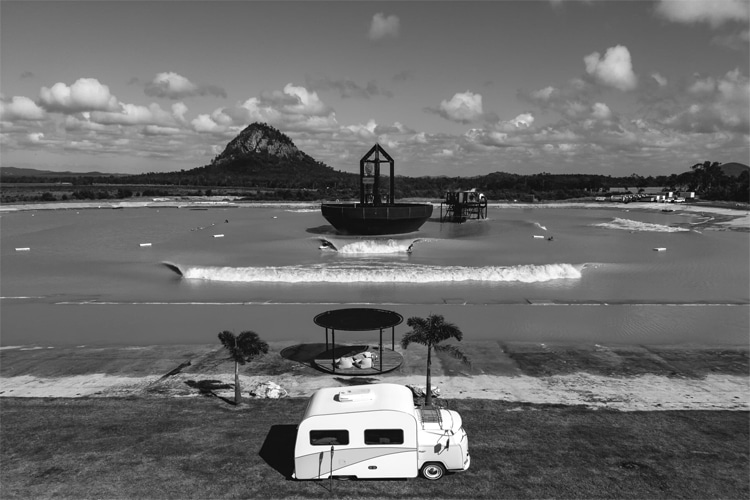
Ultimately, the massive central pump creates five different waves.
From a technical perspective, visitors will encounter circular waves that bend around the reef and break in almost any direction.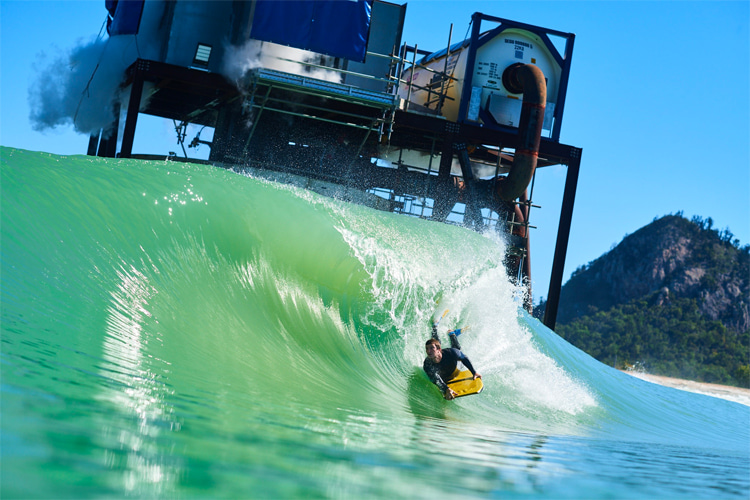
Surf Lakes can deliver over 2,000 waves per hour – that’s 33.3 waves per minute or one every two seconds on average.
The Australian wave pool concept creates ten separate waves for each swell pulse to maximize the commercial return per kilowatt hour (kWh), thanks to reliable, high-end electric compressors.
“The one wave spreads out in a circle, and it’s going to all these different breaks. You can’t keep your eye on watching all these different breaks break,” underlines big wave surfer Mark Mathews.
“There’s a crazy, slabbing pit there, a perfect peak here, and then there’s another Trestles-like fun wave over there, and you’re trying to see what each wave’s doing, and you can’t keep your eyes on all.”
“You just really have to be there to actually see how amazing the waves are and how crazy the whole structure and machinery works,” adds professional surfer Macy Callaghan.
In the original test site, the achievable wave height is proportionally aligned with stroke height, i.e., the vertical distance that the plunger can go up and down.
It started running at 13 feet (four meters), creating 6.5-foot (two meters) waves. However, potentially, the plunger’s stroke can reach 18 feet (5.5 meters), thus, bigger waves.
The company aims to generate 15-foot waves (4.5 meters) in their larger commercial installments.
The Yeppoon facility proved that the system could produce artificial waves for several water sports, including surfing, longboarding, bodyboarding, stand-up paddleboarding (SUP), kneeboarding, and surf skiing.
More than 200 wave-riding enthusiasts can enjoy Surf Lakes per hour.
The wave pool bottom floor is slip-resistant and simultaneously non-abrasive.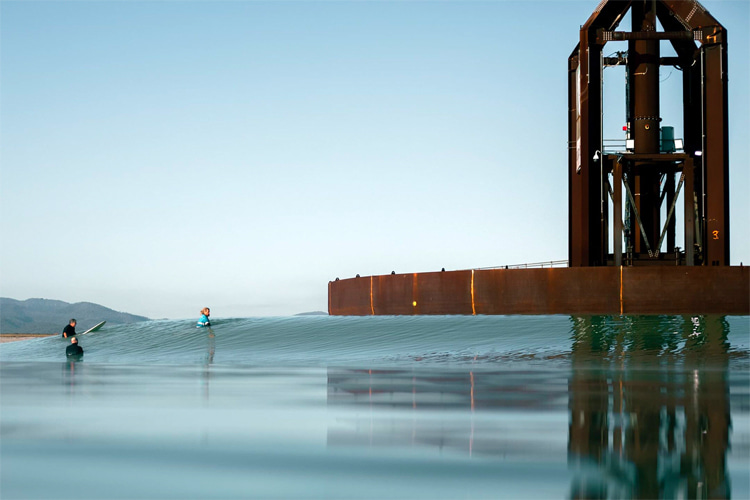
Maintenance is also not a problem.
“Our machine is completely accessible without getting wet. You don’t have to enter the water to inspect or maintain it,” adds Sidwell.
“You can inspect every single structural item without getting wet, and that’s good because if we’re in the water, we just want to be surfing.”
In commercial facilities, the system allows to draw off water, filter it, chlorinate it, and return it for crystal clear conditions all year round.
The ultra-filtration and disinfection treatment system ensures high-quality water, similar to the one available in swimming pools, thanks to an intelligent water treatment management solution.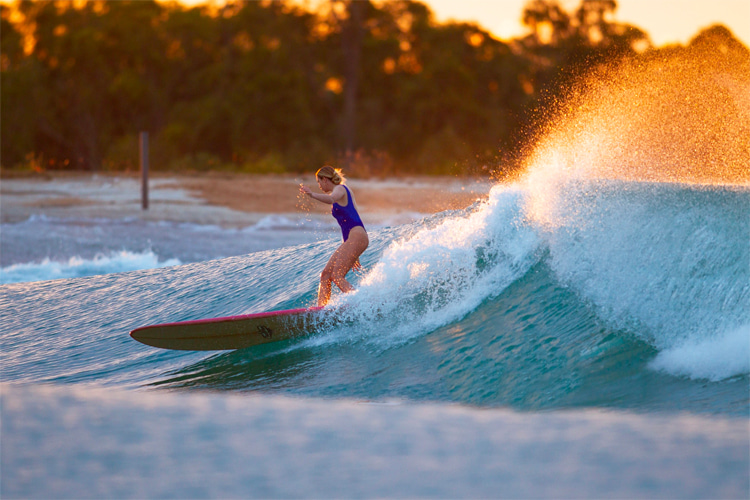
The concept that mimics ocean waves is available in three sizes:
The surfing customer is expected to pay $50 for an hour-long session at Surf Lakes.
All future commercial projects can work as a standalone surf park or be incorporated into larger entertainment facilities, such as summer resorts or theme parks.
Thanks to its circular shape, the wave pool could create up to 800 yards of shoreline, meaning plenty of space for maximizing the investment with cafés, restaurants, hotels, shops, accommodation, etc.
“With the commercial machine, we duck the water vapor into a chamber below the water line of the lake that is then released from there through attenuators into the air,” notes Kit Sidwell, co-inventor and lead machine and R&D engineer at Surf Lakes.
“The good thing about that is that most of the sound is released below the water level in the lake where you can’t hear it. The remaining amount that comes out is very small.”
The first public Surf Lakes wave pools will open across the globe from 2025-2030.
© 2023 SurferToday.com | All Rights Reserved